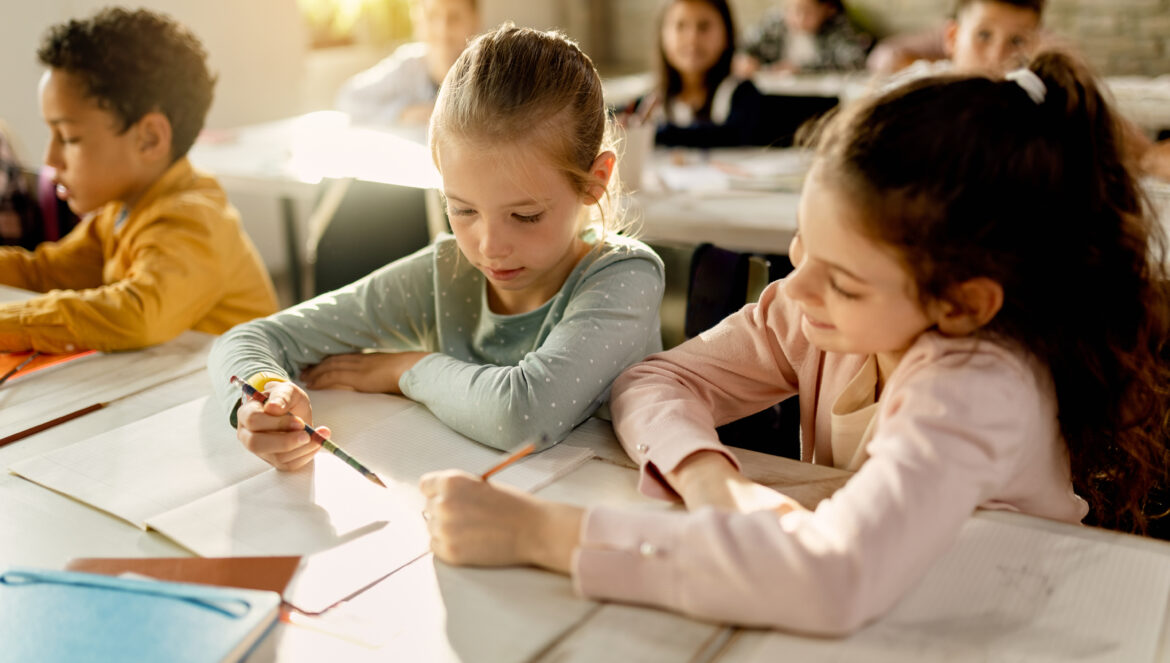How many different strategies do you use to teach others what you know? At work? At home? At play? How many of these strategies do you teach your students so they can support their peers in learning more? If we consider how students already teach each other nonacademic stuff (like Minecraft, skateboarding or Fortnight, for example), how can we tap into what they do related to life and fun and apply it to academics?
Kids learn from other kids all the time. Now that your juices are flowing, you can see that the list of potential strategies to accomplish this task—empowering students to be instructional resources for one another—is long. Let’s see if we can link some nonacademic strategies to academics. Start with something simple like learning to open a locker. The more experienced student sees the newbie struggling a bit. They walk over and offer to demonstrate. Then they stand there and watch as the newbie does it. They may offer suggestions about going a little beyond or being right on the mark (feedback). Success may take a couple of tries, but it happens. Strategy = modeling and focused peer feedback.
Or what about learning a new track and field skill? This lesson might start with some feedback from a peer about arm and feet position. Ideas are offered about what to pay attention to when leaving the starting block in a race and how to move the head and arms. The sprinter starts, and more feedback is provided about what worked and where to adjust. Modeling by the peer might even follow. The strategies used include peer teaching, peer assessment, peer feedback, and modeling. An opportunity to learn from a peer.
Peer teaching, peer feedback and modeling all require communication skills and collaboration. Being able to ask questions, actively listen, provide constructive feedback and clearly express one’s ideas are vital to effectively supporting peers in the classroom. Equally important to these individual skills is the culture of learning established by the teacher. Having a teacher who fosters a supportive and inclusive classroom is essential. Both psychological safety and trust must prevail for a sense of community and respect to exist where learners are willing to serve as instructional resources for one another.
Have you ever participated in a jigsaw activity to process multiple pieces of information? Imagine doing the same with students. Jigsaw strategies empower the learner and provide a structure that supports the development of sharing content knowledge with peers–a way of peer teaching. Divvy up the content needed to be learned and let small groups become experts on one piece of content (expert jigsaw strategy). These experts then teach their peers this information. Any of these three jigsaw strategies provides opportunities for learners to teach peers.
- Expert Jigsaw (learning for and with peers): Form multiple groups of five or six learners. Count off one to five, or however many learners are in the group. The ones from each group form an expert group to work through a scenario or complete research. They then return to their original groups to share what they learned. Think about distributing tasks that will take a similar amount of time to complete, even though the readings may differ in topic and length.
- Pieces-Make-the-Whole Jigsaw (learning with and from peers): Split a reading into multiple pieces with each learner in a small group taking a part to read individually. When learners complete their reading, they share their parts with the whole group. In this way, each part is essential for the entire group to understand the whole picture of the text.
- Building Jigsaw (learning with and from peers): Distribute different readings connected in some way to the topic to each small group of learners. When each learner has finished reading individually, the small group shares and uses each reading to find connections and build deeper knowledge.
Key ingredients from these examples for activating learners to be instructional resources for one another seem to be modeling, peer teaching, peer assessment, and peer feedback. While some of these skills are innate as evidenced in helping each other learn nonacademic skills, some are not. And all these skills are ones that learners can grow with. Part of our role as educators is to observe–catch our learners in the act of using these skills without planning to and then provide intentional context to help students make transfers between nonacademic and academic practice. By implementing strategies like these and creating a culture that promotes peer learning, students can actively contribute to each other’s educational journey.
Some of the most interesting (and exciting) observations are when learners are sharing what they know and can do so that a peer can (and does) learn from them. When was the last time you had the opportunity to learn with, from and for someone else? What was in place–environmentally, strategies, resources, time, etc. to make it happen? If it was an opportunity you were providing, what did you intentionally set up? What strategies do you use to establish a classroom environment where students learn with, from, and for each other? What have you found works best for your learners? What are you doing tomorrow that empowers learners to be instructional resources for one another?
Resources
Peer Learning: Overview, Benefits, and Models (wgu.edu)
Using Student Self-Selected Groups For Classroom Success | (edcircuit.com)






